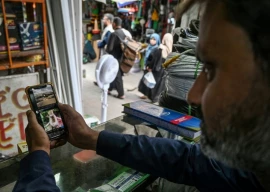
GILGIT: The emergency created by a massive landslide that struck Hunza’s Attabad village on January 4 last year refuses to subside.
Thousands living up and down the 23-kilometre-long lake are still under threat from the lake that was created by the landslide.
Many people in Gilgit-Baltistan believe that the Attabad Lake disaster is the biggest-ever calamity to have hit the region.
“It is such a big disaster that even the region’s history is silent about it [in shock],” says Farman Karim, who lost four of his family members in the disaster.
At least 20 people died in the landslide that blocked the Hunza River, creating a lake that gradually expanded 23 kilometres upstream, submerging four villages – Ainabad, Shishkat, Gulmit and Gulkin. The landslide also blocked the Karakoram Highway (KKH), a vital trade link to China, cutting off 26,000 people in Upper Hunza Valley, also known as Gojal Valley. The debris obstructed nearly three kilometres of the once fast-flowing river and a longer stretch of the highway.
As KKH came under water, the people of Gojal could travel down to Gilgit and the rest of Pakistan only by boats that sailed across the lake. But as temperatures dropped, boat rides became tougher.
“The journey via boats in winter in the frozen lake has been extremely precarious now and doing so is highly risky,” said Ali Ahmed. “But there is no alternative so what else can we do but risk our lives?”
While a number of families were cut off from other areas, many others had to vacate their homes for safer areas.
Ali Panah, a volunteer with the FOCUS Humanitarian Assistance group, said that about 120 families were still living in the Altit Camp in Hunza while nearly 50 had either taken refuge with their relatives in Gilgit or were living in rented houses in Hunza and Gilgit. “The biggest problem faced by them is lack of heating in such harsh winter,” Panah said. “None of the fuel provided by the Chinese government has been given to these Internally Displaced Persons (IDPs).”
By way of compensation, the federal government provided Rs500,000 to those who died in the disaster. Another Rs500,000 were given by the Punjab government and Pakistan Baitul Maal gave Rs25,000.
“In all, the amount paid to each aggrieved family was Rs125,000,” said an official of Hunza district’s administration. A sum of Rs100,000 was provided to each of the 249 families that lost their property as the lake expanded to villages upstream. Meanwhile, those 141 families that were affected in the Sarat and Attabad villages were provided Rs200,000 each.
The official said that the United States Agency for International Development (USAID) provided Rs12.8 million to those whose businesses were affected. But the fact that the lake still hasn’t been drained frustrates many residents.
“Look at our government, it claims one thing but does another,” Ghulam Nasir, a resident of Gulmit in Gojal, said. “Life is miserable for us as we can’t reach Hunza or Gilgit in an emergency. But we don’t fear further losses...all we had is already lost.”
But those living in villages downstream remain fearful as a spillway to drain the lake did not work and the lake can still submerge these villages. It was this fear that forced the government to evacuate nearly 20,000 people from 36 villages.
“I was one of the thousands who left their houses in July in fear of the lake bursting its banks,” said Munir Ali, a resident of Nomal, one of the villages downstream where the government had erected tents in high-altitude areas to accommodate IDPs.
As the media picked up the issue in March 2010, the National Disaster Management Authority (NDMA) spearheaded the relief and rescue operations in the affected area, digging up a spillway that was completed by mid-June. Although water flowed out from the spillway, it wasn’t enough to drain the lake. The government said that it had evacuated people following the advice of engineers from the Frontier Works Organisation, National Engineering Services Pakistan (Nespak) and FOCUS Humanitarian Assistance group. However, three months later, all IDPs were asked to return home as calculations of an outburst proved wrong.
Published in The Express Tribune, January 4th, 2011.























































COMMENTS (3)
Comments are moderated and generally will be posted if they are on-topic and not abusive.
For more information, please see our Comments FAQ